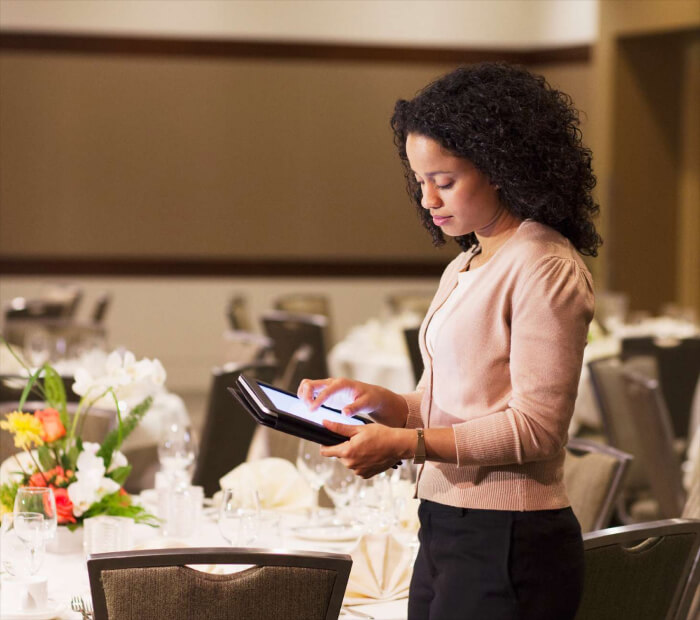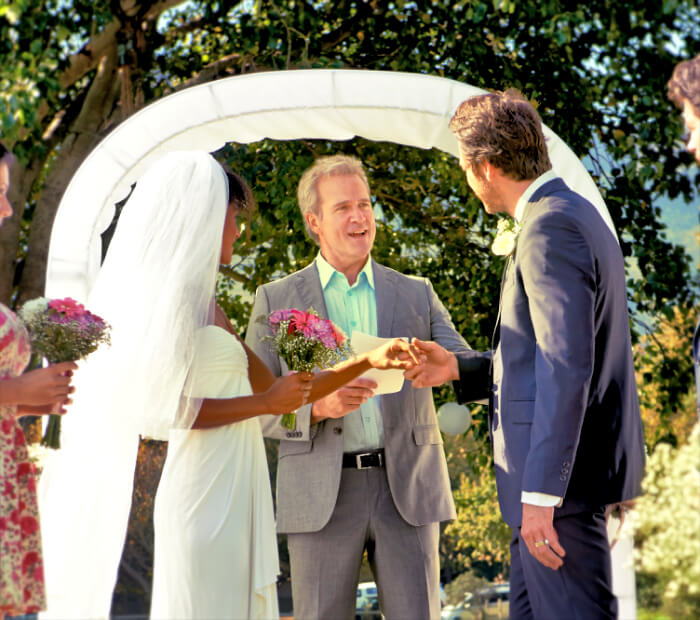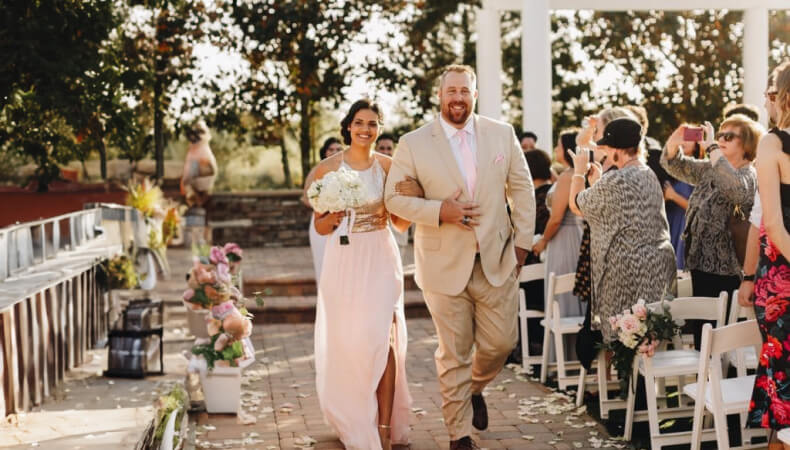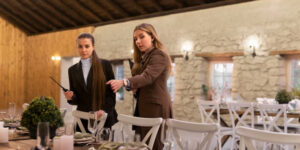Starting the journey toward your wedding day involves careful preparation, emotional moments, and, of course, the crucial rehearsal. This formality before the big event is crucial to making sure everything falls into place and creating the ideal atmosphere for a faultless wedding rehearsal.
Excitement is in the air as you get together with your closest friends and family. With the help of seasoned pros and a carefully thought-out strategy, your wedding ceremony rehearsal transforms from practice into a treasured precursor to the enchantment ahead. Come along as we explore the 12 crucial stages that will help you create a wedding ceremony rehearsal that is absolutely perfect.
Here is a complete Wedding Ceremony Rehearsal Guide
➤ Before the Rehearsal
1. Recruit a Wedding Coordinator
Hiring a seasoned wedding coordinator is not just a luxury but also a calculated step toward a more seamless, stress-free rehearsal and wedding. These experts can handle all of the technical aspects and yet let the couple enjoy the moment since they have a plethora of expertise and experience.

A coordinator’s presence guarantees efficiency and reduces last-minute glitches, freeing the couple to concentrate on what really matters: their love and devotion to one another. They may handle logistics and provide vital counsel.
2. Pair Off the Wedding Party
While choosing the bridesmaids and groomsmen may appear easy, much thought must go into the pairings to maintain harmony and balance within the group. Effective matching strategies include physical characteristics, prior relationships, personality dynamics, and physical traits.
Couples may create a cohesive and encouraging environment among their closest friends and family members by being forthright about anticipated difficulties and skillfully handling any delicate circumstances.
3. Decide on the Party entry
The ceremony’s tone is established, and the couple’s distinct tastes and style are reflected in the way the wedding party makes their grand entry. Choosing between a customary procession and other options is something that should be discussed with the officiant in order to make sure that the choices are in line with the ceremony’s overall meaning and atmosphere.
Through careful consideration of several possibilities and professional help, couples may create an entrance that aligns with their wedding day vision.
4. Establish Processional Order
A smooth and aesthetically spectacular processional is largely dependent on the order in which the wedding party approaches the ceremony space. Choosing the sequence according to things like height, the nature of the relationship, or personal tastes guarantees a smooth transition and makes it unforgettable for everyone.
Partners may create the perfect environment for an engrossing and emotional ceremony by carefully considering the processional sequence and explicitly conveying expectations.
5. Pick Your Aisle Escorts
Aisle escorts play a crucial part in wedding ceremonies; they represent the assistance and direction provided to a couple as they set off on their journey together. Choosing those who best represent this idea and thanking them for coming emphasizes how significant their participation in the event is.
Mates may deepen their relationship with their selected escorts and make the occasion more memorable by expressing gratitude for their escorts’ attendance and recognizing their importance.
6. Provide Readings to Readers
Readings during the ceremony give the proceedings more depth and individuality while bringing treasured memories and thoughts to life. Giving readers plenty of early notice for their reading materials gives them a chance to get acquainted with the passages and present them with assurance and authenticity.
Couples may enhance the ceremony experience and leave a lasting effect on both themselves and their guests by proactively providing reading materials and providing assistance to those who read them.
7. Discuss Ceremony Elements with the Officiant
Working together with the officiant is crucial to creating a ceremony that accurately captures the couple’s ideals, values, and romance. Talking about the ceremony’s components, tastes, and any religious requirements makes for a seamless and significant event that is customized to the couple’s particular path.

They may design a ceremony that really speaks to their hearts and makes an impact on everyone in attendance by communicating openly and following the officiant’s instructions.
8. Consider the Inclusion of a Receiving Line
Choosing to have a receiving line gives couples the chance to individually welcome and thank their guests, creating a feeling of appreciation and connection. Couples may make well-informed choices about whether to include a receiving line in their wedding day schedule by being aware of its function and practicalities.
During post-ceremony interactions, couples can create a lasting impression on their guests by taking into account aspects like guest numbers and time management.
➤ During the Rehearsal
9. Organize the Party party line-up.
Putting together a visually stunning and expertly conducted ceremony requires careful planning of the wedding party lineup. Through careful explanation of roles for the parents, bridesmaids, groomsmen, and couple, each participant comes away with a deep grasp of their important responsibilities.
This careful planning not only gives everyone present confidence but also guarantees a smooth procession, making a lasting impression and creating the ideal atmosphere for an absolutely amazing wedding day.
10. Review Order of Ceremony Events
In order to promote clarity and confidence among all participants, it is imperative to conduct a comprehensive evaluation of the order of ceremonial activities. Giving everyone a thorough rundown enables them to become acquainted with their specific roles and responsibilities.
In addition, this special period provides an invaluable chance to clarify any doubts or problems, guaranteeing a perfect performance on the big wedding day.
11. Practice Recessional Protocol
A classy and well-organized post-ceremony exit for the wedding party can be achieved by allocating dedicated practice time for the recessional protocol. Any possible uncertainty is reduced by providing parents and visitors with explicit instructions on the order of exit and cues.
This careful planning ensures a smooth transition, which culminates in a moving and unforgettable ceremony finale that leaves a lasting effect on everyone there.
12. Rehearse Processional Precision
It is imperative to meticulously practice the processional in order to achieve grace and accuracy as the bridal party and couple make their arrival. Providing helpful guidance on timing, synchronization with musical cues, and pace enhances the processional’s overall visual impact and emotional resonance.
With careful attention to detail, the couple and their distinguished guests are guaranteed a thrilling and unique event that evokes sincere feelings and creates cherished memories.
FAQs
What do you do at a wedding rehearsal?
During a wedding rehearsal, attendees convene to rehearse the ceremony in order to verify that all elements are in perfect harmony prior to the momentous occasion. Organizing the array of the wedding party, rehearsing the processional and recessional, and reviewing the sequence of ceremony events are customary components of the rehearsal.
It is an opportunity to clarify roles, coordinate indicators, and respond to any last-minute inquiries or concerns. In addition, by ensuring that all parties are in agreement, couples may finalize logistics with their officiant and wedding coordinator. In essence, the rehearsal functions as a significant occasion to refine the ceremony, mitigate anxiety, and foster self-assurance in preparation for impeccable wedding festivities.
Who should be at the rehearsal?
During the wedding rehearsal, essential attendees generally consist of the married couple, their wedding party, the officiant, and occasionally other members of the immediate family. Attendance by those directly engaged in the ceremony is critical in order to review the logistics and verify that all participants are aware of their respective responsibilities. This includes readers and performers in addition to attendants, groomsmen, flower girls, and ring bearers.
Moreover, it is advantageous for the couple to extend an invitation to their wedding planner or coordinator, should they possess one, to supervise and offer direction during the rehearsal. Although the presence of every visitor is not required, certain couples opt to extend invitations to intimate relatives or distinguished guests in order to observe the ceremony and engage in the festivities.
How long should it last?
Pertaining to the intricacy of the rite and the number of attendees, the customary time span for a wedding rehearsal is between thirty minutes and one hour. Ensuring that every facet of the ceremony is attended to without becoming excessively laborious requires striking a balance between efficiency and thoroughness.
A rehearsal that is adequately organized and planned should provide sufficient time for participants to rehearse the sequence of events, walk through the processional, and practice any necessary rituals or readings. In preparing for the wedding day, it is essential to maintain a productive and focused rehearsal by ensuring that all attendees adhere to the designated time and avoiding superfluous disruptions.
What is the dress code?
Typically, smart casual or semi-formal clothes are required for wedding rehearsals. It is advised that participants dress modestly and comfortably—avoid wearing too much formal or informal clothing. Looking nice is the main priority, but maintaining mobility for the ceremony’s practice is also important.
In conclusion, a faultless wedding ceremony rehearsal experience demands careful preparation, unambiguous communication, and close attention to detail. Couples may make sure that every element of their ceremony is carefully planned and done with ease by adhering to the 12 important stages that are detailed.
Every step of the preparation process is important, from planning the wedding party roster to rehearsing the processional and reviewing the ceremony’s activities. When couples put in the necessary work and have the help of their wedding organizer and officiant, they can approach their rehearsal with confidence.




![The Ultimate Wedding Photo-shoot Checklist [2024] The Ultimate Wedding Photo-shoot Checklist [2024]](https://www.happywedding.app/blog/wp-content/uploads/2024/04/The-Ultimate-Wedding-Photoshoot-Checklist-300x150.jpg)


